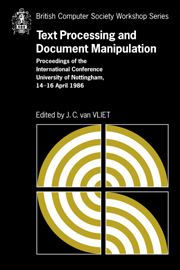 Text Processing and Document Manipulation
Text Processing and Document Manipulation Published online by Cambridge University Press: 05 May 2010
ABSTRACT
In this paper, a system for interactive creation and browsing of dynamic documents is described. The Concept Browser allows the user to create a semantic network of interrelated concepts and interactively navigate through the network. Outlines and printed documents can be automatically generated from the network of concepts. The Concept Browser has been designed and implemented in a Smalltalk programming environment. An interactive, window-based user interface is provided that allows the user to browse through and modify the network of concepts.
Possible applications for the Concept Browser are in the areas of on line documentation, tutorial systems, document preparation systems and electronic books.
Introduction
The traditional method of storing information in a printed, linear form as it is done with conventional books has been demonstrated to be inadequate both to represent the complexity of information and to offer quick and flexible access to it [8].
The personal computer appears to be the ideal tool to satisfy these requirements, but a simple computer-based transcription of traditional books is not the best way of taking advantage of the new functionalities offered by computers.
The purpose of this article is to describe one experiment in the design of a documentation system that can take advantage of the flexible data structures and advanced user interface provided by a Smalltalk programming environment.
A semantic network was chosen as the best way of representing the complexity of information ([4],[6]) instead of a more traditional tree structure [5].
To save this book to your Kindle, first ensure [email protected] is added to your Approved Personal Document E-mail List under your Personal Document Settings on the Manage Your Content and Devices page of your Amazon account. Then enter the ‘name’ part of your Kindle email address below. Find out more about saving to your Kindle.
Note you can select to save to either the @free.kindle.com or @kindle.com variations. ‘@free.kindle.com’ emails are free but can only be saved to your device when it is connected to wi-fi. ‘@kindle.com’ emails can be delivered even when you are not connected to wi-fi, but note that service fees apply.
Find out more about the Kindle Personal Document Service.
To save content items to your account, please confirm that you agree to abide by our usage policies. If this is the first time you use this feature, you will be asked to authorise Cambridge Core to connect with your account. Find out more about saving content to Dropbox.
To save content items to your account, please confirm that you agree to abide by our usage policies. If this is the first time you use this feature, you will be asked to authorise Cambridge Core to connect with your account. Find out more about saving content to Google Drive.